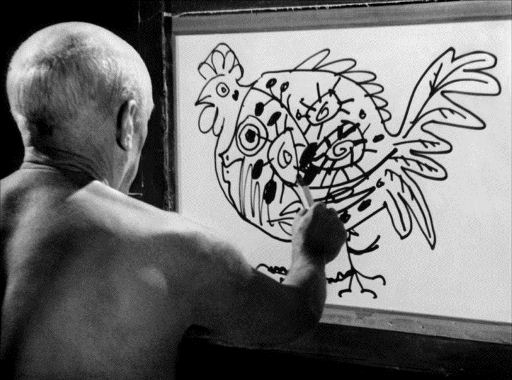Available on Blu-ray Mon 22 January 2018
Henri-George Clouzot wasn’t averse to a mystery. Indeed, his most famous work Les Diaboliques is considered a seminal film of the 1950s. Here, he turns his attention to a more nebulous quandary: how to capture the essence of a great artist at work. His solution, albeit one with questionable success, is to film the creation of a series of paintings in-studio by the legendary Pablo Picasso. To merely film the artist as he works would seem banal however; Clouzot seems to believe that only through the art itself can the artist be revealed.
For the most part the screen is filled with the canvas, treated with a substance that lets the ink permeate right through. In this way Clouzot can film the ink and paint as it’s applied with Picasso painting, and out of shot, on the other side. It’s a dynamic style, even if it undermines the director’s opening voice-over which insists that, “To follow the painter’s thoughts, we need only follow his hands.”
At first the painting is accompanied only by the scratches and drips of the material as the artist goes about his brisk business. Soon, a dextrous, varied score by Georges Auric is added. It matches the painting beautifully, giving the impression that it’s being improvised there-and-then. Sensuous woodwind match reclining nudes, brash flamenco guitars and castanets back savage bullfight scenes, tribal rhythms hammer away over Incan-style abstraction, and skittering jazz drums form a chattering commentary on a reprise of his famous Cubist work.
At first, it’s a fascinating glimpse of art-in-motion, and an attempt to meld a static, sedentary form with a bustling, kinetic one. This is exemplified with a break in the established formula where Clouzot is seen in conversation with Picasso, informing him that for one they’re working against the clock for one painting due to limited film in the camera. It then cuts between the bright-eyed Picasso, the director, and cinematographer Claude Renoir as the time ticks away and paint is hurled.
After this, normal service is resumed and, even for the most intent of aficionados, The Mystery of Picasso becomes something of a slog, even at a lean 75 minutes. It’s great that such curios continue to be unearthed and distributed again by companies like Arrow, but like The Creeping Garden last year, a documentary on slime moulds, this is likely to be something of a niche title. Also, while none of these twenty paintings are likely to be considered masterpieces, the knowledge that all were burned immediately after filming feels like an act of cultural self-immolation to rival The KLF burning £1m four decades later. For a work intended as a feast of art it leaves something of a bad taste in the mouth.
